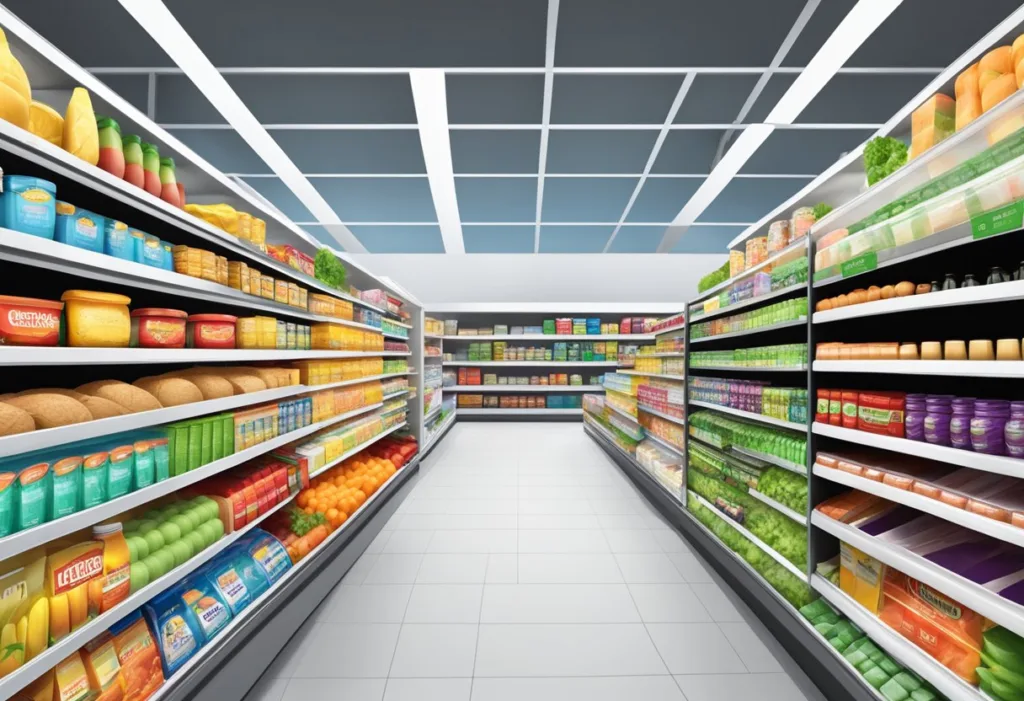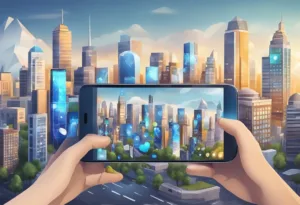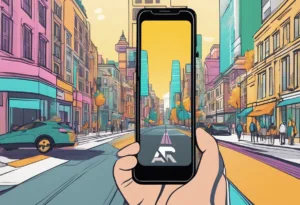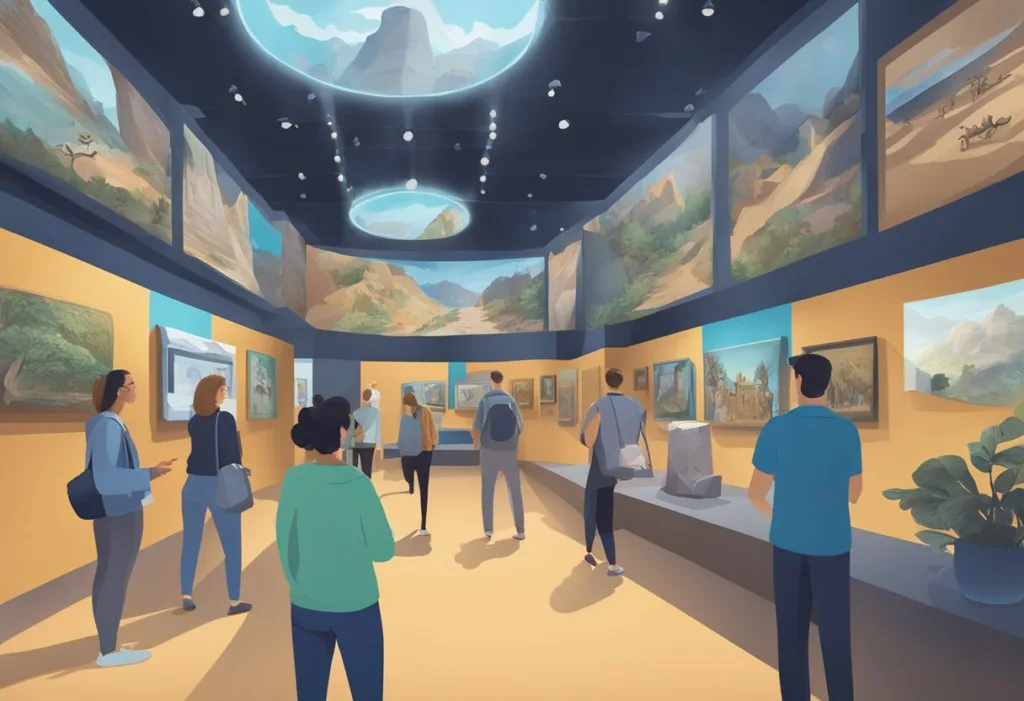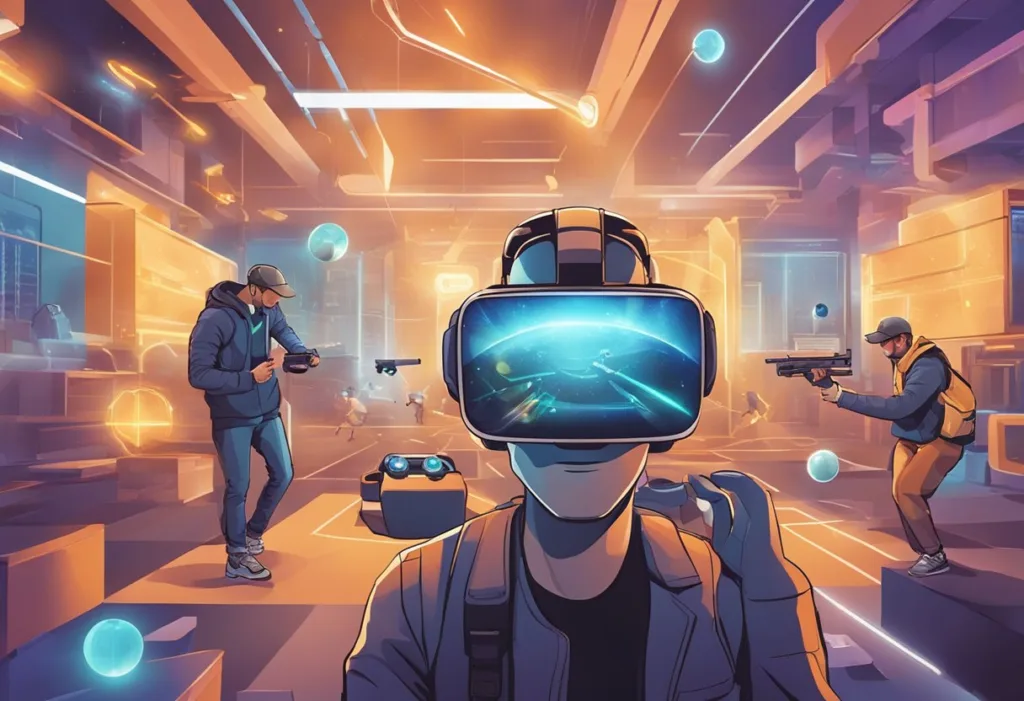Augmented reality (AR) has been gaining popularity in the world of retail, and grocery shopping is no exception. AR grocery shopping technology allows customers to use their smartphones to view digital images of products in the store and get additional information about them. This technology is designed to enhance the shopping experience by providing customers with more information about the products they are interested in and making it easier for them to find what they are looking for. In this blog post, we will explore the concept of augmented reality grocery shopping and the 15 AR grocery stores.
The evolution of shopping has led to the integration of technology, and AR is one of the latest technologies that retailers are adopting to enhance the shopping experience. The use of AR in grocery shopping is still in its early stages, but it has already shown great potential. Retailers are using AR to help customers find products more easily, learn more about products, and even see how products will look in their homes before making a purchase.
Key Takeaways
- Augmented reality is a technology that is being used in grocery shopping to enhance the shopping experience.
- AR is being used to help customers find products more easily, learn more about products, and even see how products will look in their homes before making a purchase.
- Retailers are adopting AR to stay competitive and provide customers with a better shopping experience.
Evolution of Shopping
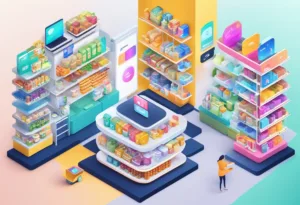
From Brick-and-Mortar to E-Commerce
The retail industry has undergone significant changes in recent years, with the rise of e-commerce being one of the most notable. Brick-and-mortar stores have traditionally been the primary way people shopped for goods, but the advent of online shopping has changed the way people shop. E-commerce has enabled people to shop from the comfort of their homes, making it easier and more convenient to purchase goods.
Online shopping has also made it easier for retailers to reach a wider audience, as they are no longer limited by physical location. This has led to increased competition in the retail industry, as retailers must now compete with both online and brick-and-mortar stores.
Impact of the Pandemic on Retail
The COVID-19 pandemic has had a significant impact on the retail industry. With many people forced to stay at home, online shopping has become more popular than ever before. According to a report by eMarketer, e-commerce sales in the US increased by 32.4% in 2020, compared to the previous year.
The pandemic has also led to changes in the way people shop. With social distancing measures in place, many people have turned to online shopping to avoid crowded stores. This has led to an increase in demand for online shopping services, as retailers rush to meet the needs of their customers.
The retail industry has undergone significant changes in recent years, and the COVID-19 pandemic has only accelerated these changes. As retailers continue to adapt to changing consumer needs, it will be interesting to see what the future holds for the retail industry.
Augmented Reality in Grocery Shopping
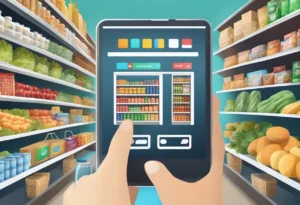
Augmented reality (AR) technology is rapidly changing the way people shop for groceries. AR technology is an immersive experience that blends digital data with real-world imagery via a camera lens. This technology provides users with a composite view of the real world and virtual images.
Understanding AR Technology
AR technology has been around for a while, but it is only recently that it has become popular on modern smartphones. With AR technology, users can interact with digital objects in the real world, creating a more immersive experience. AR technology provides users with the ability to see the virtual images in real-time, making it an exciting and engaging experience.
AR Apps and Their Functions
AR grocery shopping apps are becoming increasingly popular. These apps assist shoppers in making healthier decisions as they decide which grocery products to buy. The apps provide real-time information about products, customized deals, and interactive experiences. AR grocery shopping apps also provide users with the ability to interact with digital objects in the real world, creating a more immersive experience.
AR technology is helping to amplify and redefine the shopping experience. Grocery retailers are adopting AR technology to boost their conversions and attract more customers. The use of AR technology in grocery retail is expected to grow in the coming years, as more retailers see the benefits of this technology.
AR technology is changing the way people shop for groceries. AR technology provides an immersive experience that blends digital data with real-world imagery via a camera lens. AR grocery shopping apps are becoming increasingly popular, providing users with real-time information about products, customized deals, and interactive experiences. Grocery retailers are adopting AR technology to boost their conversions and attract more customers.
15 ways Augmented Reality can enhace grocery shopping
- Interactive Product Information
- Nutritional Information and Health Tracking
- In-Store Navigation
- Virtual Coupons and Deals
- AR Shopping Lists
- Product Comparison
- Allergen Alerts
- Recipe Suggestions
- Personalized Recommendations
- Gamified Shopping Experiences
- Remote Shopping Assistance
- Sustainable Shopping Guidance
- Instant Customer Reviews
- Virtual Cooking Classes
- AR Enhanced Brand Storytelling
Interactive Product Information
Augmented reality grocery shopping can transform the way customers interact with products by providing interactive information. With AR, shoppers can scan items to reveal detailed product specifications, sourcing details, and even brand stories. This enriched content helps customers make more informed choices and enhances the overall shopping experience by bringing a depth of knowledge that goes beyond traditional labels.
Nutritional Information and Health Tracking
Augmented reality grocery shopping can offer immediate access to nutritional information, making it easier for customers to adhere to dietary plans or restrictions. By scanning products with an AR app, shoppers can see a breakdown of calories, macros, and vitamins. This feature can integrate with health tracking apps to help maintain dietary goals, offering a seamless and interactive way to shop healthily.
In-Store Navigation
Navigating a grocery store can be time-consuming, but augmented reality can streamline this process. AR in-store navigation can guide shoppers directly to the items on their list, suggest the most efficient route through the store, and even highlight items that are on sale. This not only saves time but also improves the overall shopping experience by reducing frustration.
Virtual Coupons and Deals
Augmented reality can enhance grocery shopping by providing virtual coupons and deals directly to the shopper’s smartphone. As customers walk through the store, AR can alert them to discounts on nearby items or offer exclusive deals when they scan a product. This not only incentivizes purchases but also adds a layer of excitement to the shopping trip.
AR Shopping Lists
AR shopping lists can revolutionize the way customers shop by visually guiding them to the products they need. Shoppers can create a digital list, and the AR app will overlay directional cues on the real-world store environment, leading them to each item. This interactive list can update in real-time as items are added to the cart, ensuring nothing is forgotten.
Product Comparison
With augmented reality grocery shopping, customers can easily compare products side by side. By scanning multiple items, AR can display comparative information such as price, nutritional content, and customer ratings, helping shoppers make the best choice for their needs and budget.
Allergen Alerts
For those with food sensitivities, augmented reality can provide allergen alerts. Shoppers can input their dietary restrictions into an AR app, which will then highlight or alert them to products that contain these allergens as they shop. This proactive approach enhances safety and convenience for individuals with specific dietary needs.
Recipe Suggestions
Augmented reality grocery shopping can make meal planning more interactive by suggesting recipes based on the items shoppers scan or have in their cart. This can inspire customers to try new dishes and help them ensure they have all the necessary ingredients, making shopping more efficient and enjoyable.
Personalized Recommendations
AR can offer personalized product recommendations based on a customer’s shopping history, preferences, and dietary needs. By analyzing past purchases and selected preferences, the AR system can suggest new products, alternatives, or items that complement those already chosen, creating a tailored shopping experience.
Gamified Shopping Experiences
Augmented reality can gamify the grocery shopping experience by incorporating challenges, rewards, and interactive elements. Shoppers could earn points for making healthy choices, completing scavenger hunts for items, or participating in AR-based store promotions, making shopping more engaging and potentially influencing buying behavior.
Remote Shopping Assistance
AR can provide remote shopping assistance by connecting customers with store employees or bots that can help them find items or answer questions. This virtual assistance can be accessed by scanning a product or store signage, offering real-time help without the need to physically locate a staff member.
Sustainable Shopping Guidance
For eco-conscious shoppers, AR can highlight sustainable products and practices. By scanning items, customers can learn about a product’s environmental impact, packaging recyclability, and the sustainability efforts of the brand, encouraging informed and eco-friendly purchasing decisions.
Instant Customer Reviews
AR can give shoppers instant access to customer reviews and ratings by simply scanning a product. This immediate feedback can influence purchasing decisions and provide a level of transparency that builds trust and satisfaction with the shopping experience.
Virtual Cooking Classes
Grocery stores can use AR to offer virtual cooking classes, where shoppers can scan a product and be guided through a recipe step by step in an immersive experience. This not only provides cooking inspiration but also encourages the purchase of all the ingredients needed for the dish.
AR Enhanced Brand Storytelling
Augmented reality grocery shopping can bring the stories behind brands and products to life. By scanning items, shoppers can view videos, images, and narratives that share the heritage, production process, and unique selling points of products, creating an emotional connection and enhancing brand loyalty.
Enhancing Customer Experience in AR Grocery Stores

Augmented reality (AR) is revolutionizing the grocery shopping experience by providing customers with a dynamic and personalized way of shopping. AR technology enhances the customer experience by providing features such as virtual try-on, nutritional information and allergens, and wayfinding and store layout.
Virtual Try-On and Personalization
AR provides customers with a virtual try-on experience, allowing them to see how a product looks on them before making a purchase. This feature enhances the customer experience by giving them a more personalized shopping experience. With AR, customers can customize their shopping experience by choosing the color, size, and style of a product.
Nutritional Information and Allergens
AR technology can provide customers with nutritional information and allergen warnings for products. This feature enhances the customer experience by providing them with the necessary information to make informed decisions about their purchases. With AR, customers can scan a product and receive information about its ingredients, nutritional value, and potential allergens.
Wayfinding and Store Layout
AR technology can also help customers navigate the store by providing them with wayfinding and store layout information. This feature enhances the customer experience by making it easier for them to find the products they need. With AR, customers can use their mobile devices to scan the store and receive information about the location of products, promotions, and other relevant information.
AR technology is transforming the grocery shopping experience by enhancing customer engagement and providing a more personalized shopping experience. With features such as virtual try-on, nutritional information and allergen warnings, and wayfinding and store layout information, customers can enjoy a more seamless and enjoyable shopping experience.
Retailer Benefits and Strategies

Augmented reality (AR) grocery shopping provides retailers with a range of benefits, including increased sales and brand loyalty, as well as the ability to gather customer behavior data. By implementing an effective AR strategy, retailers can improve their conversion rates and gain valuable insights into their customers’ shopping habits.
Increasing Sales and Loyalty
AR can be used to enhance the customer experience and create a more immersive shopping environment. By allowing customers to interact with products in a new and exciting way, retailers can increase brand loyalty and encourage repeat business. For example, AR can be used to provide customers with detailed information about a product, such as its ingredients, nutritional value, and cooking instructions. This can help customers make more informed purchasing decisions and increase their confidence in the products they buy.
In addition, AR can be used to create personalized shopping experiences that cater to individual customer preferences. By allowing customers to customize their shopping experience based on their interests and needs, retailers can create a more engaging and enjoyable shopping experience that encourages repeat business.
Gathering Customer Behavior Data
AR can also be used to gather valuable customer behavior data that can be used to improve marketing and sales strategies. By tracking customer interactions with AR experiences, retailers can gain insights into customer preferences and shopping habits. This data can be used to create targeted marketing campaigns that are more likely to resonate with customers and increase sales.
In addition, retailers can use AR to gather real-time data on customer behavior, such as how long they spend interacting with a particular product or how often they return to a specific section of the store. This data can be used to optimize store layouts and product placement, as well as to identify areas for improvement in the customer experience.
AR provides retailers with a range of benefits that can help them increase sales, improve brand loyalty, and gather valuable customer behavior data. By implementing an effective AR strategy, retailers can create a more engaging and personalized shopping experience that encourages repeat business and drives business value.
Challenges and Considerations
Privacy and Data Security
As with any technology that involves the collection of digital data, privacy and data security are major concerns when it comes to augmented reality grocery shopping. Retailers must ensure that they are following best practices in data privacy and security to protect their customers’ personal information. This includes implementing strong security protocols, encrypting data, and being transparent about how customer data is being used.
Retailers must also be aware of the scale of data that will be generated by augmented reality grocery shopping. They will need to have the infrastructure in place to store and process this data securely. In addition, retailers will need to be transparent about how they are using this data, and ensure that customers are aware of the risks involved with sharing their personal information.
Technological Barriers and Adoption
Another challenge that retailers face when it comes to augmented reality grocery shopping is technological barriers and adoption. While the technology is rapidly advancing, there are still some limitations to what can be achieved with augmented reality in a grocery store setting. For example, the accuracy and reliability of product recognition technology is not yet perfect, which can lead to frustration and mistrust among customers.
In addition, the adoption of augmented reality grocery shopping technology by retailers and customers is not yet widespread. Retailers will need to invest significant resources to implement this technology, and customers will need to be convinced of its benefits. This will require a significant shift in the retail industry, and retailers will need to be patient as they work to overcome these barriers.
While there are certainly challenges to implementing augmented reality grocery shopping, the potential benefits are significant. Retailers who are able to overcome these challenges and successfully implement this technology stand to gain a significant competitive advantage in the retail industry.
Frequently Asked Questions
What are the benefits of augmented reality in enhancing the shopping experience at grocery stores?
Augmented reality (AR) technology offers several benefits in enhancing the shopping experience at grocery stores. Firstly, it allows customers to visualize products in a more engaging and interactive way. Secondly, it enables retailers to provide personalized recommendations and promotions to customers based on their shopping history, preferences, and location. AR technology can improve the efficiency of in-store operations by providing real-time inventory data and reducing the time required for manual stock checks.
Which companies are leading the development of augmented reality apps for grocery shopping?
Several companies are leading the development of augmented reality apps for grocery shopping, including Walmart, Kroger, and Albertsons. These retailers have invested in AR technology to provide customers with a more immersive and engaging shopping experience. Several startups such as InContext Solutions and HoloLens are also developing AR solutions for the grocery industry.
How does augmented reality improve inventory management and customer engagement for retailers?
Augmented reality can improve inventory management and customer engagement for retailers in several ways. Firstly, it enables retailers to track inventory levels in real-time, reducing the risk of stockouts and overstocking. Secondly, it allows retailers to provide customers with more personalized and targeted promotions based on their shopping history and preferences. AR technology can improve customer engagement by providing interactive product information and recommendations.
What are the innovative ways augmented reality can be used for education in virtual grocery store simulations?
Augmented reality can be used for education in virtual grocery store simulations in several ways. For example, it can be used to provide customers with interactive tutorials on how to cook certain dishes or use specific products. AR technology can be used to simulate different shopping scenarios, such as shopping for a large family or shopping on a budget, to help customers make more informed purchasing decisions.
How has Walmart integrated augmented reality into its retail operations?
Walmart has integrated augmented reality into its retail operations in several ways. For example, it has developed an AR app that allows customers to scan products and receive personalized recommendations and promotions based on their shopping history and preferences. Walmart has used AR technology to provide customers with interactive product information and recommendations in-store.
What role does AI play in optimizing the supermarket shopping experience with augmented reality?
AI plays a crucial role in optimizing the supermarket shopping experience with augmented reality. For example, it enables retailers to provide personalized recommendations and promotions to customers based on their shopping history, preferences, and location. AI can be used to analyze customer data to identify trends and patterns, allowing retailers to make more informed business decisions.

